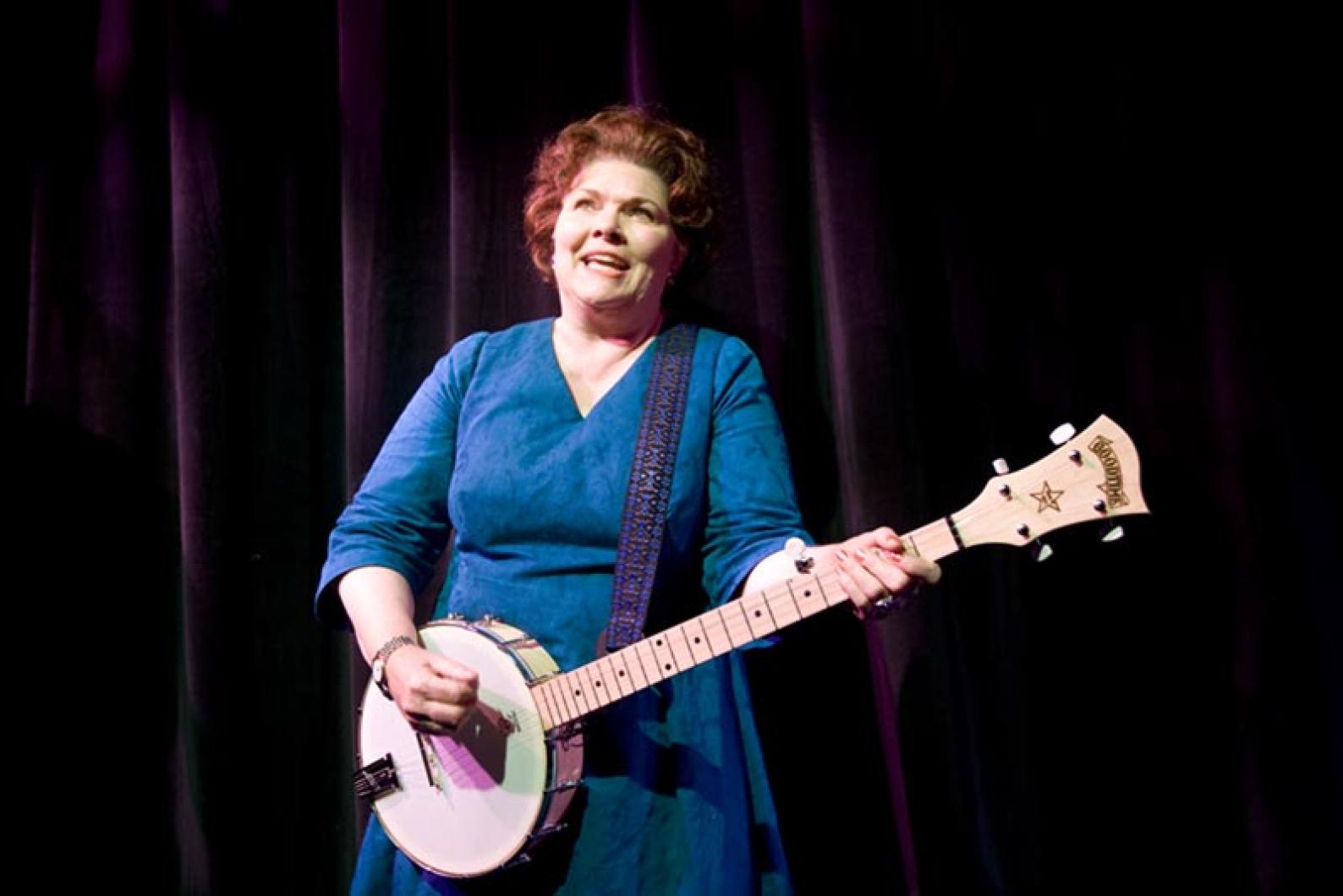A couple of years before Tiny Tim tiptoed through the tulips of America’s oddball garden of novelty singers, Mrs. Elva Miller (1907–1997) of southern California sharpened our appetite for the camp pleasure of the over-warbled, excruciating and off-pitch note. Now in the world-premiere of Mrs. Miller Does Her Thing at the Vineyard Playhouse, Pulitzer Prize-winning Broadway director and writer James Lapine brings us the story of the rise and fall of this songstress and, well, the truth must be told: laughingstock.
As the story unfolds, Mrs. Miller has no idea, at least consciously (and she is alarmingly disconnected from her unconscious) that there is anything deficient in her singing. “I’m classically trained,” she says with the glowing self-assurance of a Beverly Sills.
When the lights go up, Mrs. Miller, played by Broadway star Debra Monk (Chicago, Company, Picnic), vacuums a Persian carpet and, over the machine noise, expels Rock of Ages. It’s surprising that this middle-aged matron has come this far in life without anyone shouting at her to “Please, dear, kindly shut up!” — something family members do with frightening regularity, for while we love our own hand-selected music on CD players and iPods, often we find the less-than-professional singing of others to be downright unbearable.
But there are few to silence this quaint singer. Mrs. Miller is childless, although she’s a doting aunt to her college sophomore niece, Joelle, played by Molly Camp. And the only other person who might wince at her trumpeted church psalms is her husband (Larry Bryggman), now in a convalescent home recovering from a stroke. While Mr. Miller is unpleasant in some ways — he’s a cheapskate and a grouch — he indulges his wife’s passion, even going so far as to pay for sessions at the local recording studio. The quid pro quo comes in the form of Mrs. Miller’s icebox cake and other assorted desserts; he’s putty in her hands the minute one of these sugary treats is shoved under him. It’s clear, however, that Mrs. Miller doesn’t particularly want Mr. Miller in her hands, and his constant mention of “the device,” a medical enhancer his doctor has promised to restore him to full functioning, makes this normally cheerful woman shudder.
Elva Miller is a classic female product of the Greatest Generation. It must have been apparent to many girls growing up in the 1920s and 1930s that the only way their worried world could keep from imploding was if they played Pollyanna past the point that even Pollyanna herself could maintain her esprit de corps. Thus, Pack Up Your Sorrows In An Old Kit Bag (and Smile, Smile, Smile) and other songs of the period, exhorting people to be happy even if they had to fake it, produced thousands of women with a happ-a-stat set on auto-pilot. The psychoanalytic term for this is denial. Also suppression. Suppression means that one of these days — or indeed many of these days — the suppressed personality, like Krakatoa, is bound to blow.
It would be spoiling the plot to reveal just how Mrs. Miller goes from spinning her own stentorian versions of church hymns in her neighborhood studio to receiving a record deal with a major music company and selling 50,000 copies of the ironically titled Mrs. Miller’s Greatest Hits in the first two weeks of its release. Her path is paved by an ambitious young studio tech named Simon (Nick Blaemire); her timid niece, newly liberated from virginity by this same Simon; a typically sleazy music producer, Larry Drummond (Brad Oscar); and a trio of hugely appealing backup singers (Carly Hughes, Jacqui Polk and Eric Santagata) whose genuine talent is made even more manifest in the face of Mrs. Miller’s sheer awfulness.
We watch the 60s unfold in the characters’ change of wardrobe and attitude. In the center of it all, Mrs. Miller stays unalterable and irrepressible in a turquoise, blimp-sized matron’s dress, and with a thick black leather handbag affixed to her crooked arm. Meanwhile Joelle goes from demure mouse in shapeless 50s attire to hippy nymph in a long Madras-print skirt, thin leather vest and pink-tinted glasses. Ditto Simon, Larry Drummond and the backup singers, all sprouting over time bigger, better and shaggier iconic items of dress and coiffure (costuming by Jennifer Caprio).
The acting, singing and dancing in this production are truly sensational; even Ms. Monk, who in her “real” singing roles demonstrates musical talent to burn, does a splendid job of derailing a high C into the screech of a dying wombat. It’s an old chestnut that a painter must first display representational ability before turning to abstract design, and Ms. Monk proves this in the field of singing; she can only sing so badly by first singing well.
Part of the fun of this true-life fable is that the backup trio strut their stuff as if Aretha Franklin delivered the key vocals instead of the woefully misguided Mrs. Miller: Ms. Hughes has the quality of an updated, slightly dotty and naughty Lennon sister; Mr. Santagata as the sole male voice is incandescent with the joke of it all (plus he’s a knockout gymnast of a dancer); and Ms. Polk, as the 60s deepen, adds a bit of Motown to her moves that gives the sharpest edge to Mrs. Miller’s tone-deaf banality.
Mr. Oscar performs more roles than an actor in an under-funded community theatre production of Troilus and Cressida, including a stoned music producer and a still-more stoned and ornately-bearded emcee at the Whisky A-Go-Go.
The stylish set by Stephen M. Zablotny and Paul Munafo features a royal blue floor and two open doorways glowing orange-yellow. Sound, which is crucial to this fusillade of golden oldies music, is purveyed by Dan Moses Schreier and Jim Novack. Lighting by Jeff Croiter illuminates — no pun intended — the hell-bent passage of 1960s time, and aids Mr. Lapine’s cunning use of what in the movies they call split-screen; in this case, Mrs. Miller’s kitchen counterposed against Mr. Drummond’s office, or Simon’s apartment alongside the visiting lounge of Mr. Miller’s convalescent home.
The pièce de résistence set is the Whisky A-Go-Go, where Mrs. Miller, in a tie-dyed poncho, blasts out “One pill makes you larger, and one pill makes you small / And the ones that Mother gives you don’t do anything at all / Ask Alice when she’s ten feet tall!” Can this really have happened? you ask yourself, and you realize, yes, Mrs. Miller played the Whisky, and the most amazing part about the whole experience is that she had zilch idea that the Jefferson Airplane lyrics referred to psychedelic drugs. Even the infamous album cover for her Acid Rock hits, as she winks at the camera and proffers a platter of green brownies, undoubtedly left her thinking about running home to whip up a green Jell-o mold.
Contributing to the overall excellence, Lisa Shriver provided choreography and Michael Starobin musical direction. Mr. Starobin and Mr. Blaemire performed keyboard, T. George Davis Jr. was on guitar. There are many other credits, including Beverley Randolph, production stage manager and Geneva Monks, assistant stage manager, for the impressive crew.
Mrs. Miller Does Her Thing was co-conceived by James Lapine and Mark Oliver Everett. Mr. Lapine, whose illustrious credits include collaborations with Stephen Sondheim on Sunday in the Park With George, Into The Woods, and Passion, brought the script for Mrs. Miller to M.J. Bruder Munafo, artistic director of The Vineyard Playhouse, and the two of them hit the ground running to bring this exciting production to our shores. More and more Ms. Bruder Munafo and her theatre are specializing in world premieres of the highest caliber.
Mrs. Miller Does Her Thing runs at the playhouse until Oct. 4. For details or reservations, call the box office at 508-696-6300.







Comments
Comment policy »